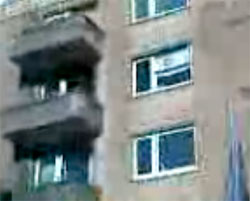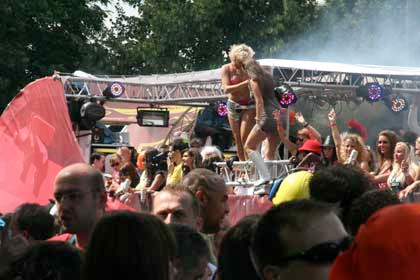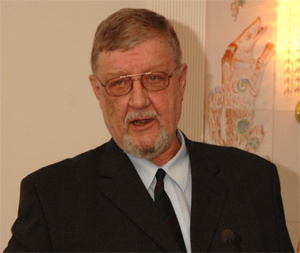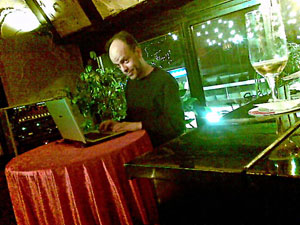 Illustration: Flickr.com / camillo(f)reaque
Illustration: Flickr.com / camillo(f)reaque
Ich bin Jüdin und lebe in Duisburg. Doch dass ich nicht wie viele in meinem Bekanntenkreis der katholischen oder der evangelischen Kirche angehöre, hatte mich bisher nicht weiter interessiert. Mit meiner Religion hatte ich wenig am Hut – oder um noch genauer zu sein: eigentlich gar nichts. Ich war, wie viele meiner Glaubensbrüder und Schwestern, die in den 30er und 40er Jahren lebten, weitgehend in die deutsche Gesellschaft assimiliert.
Ich spare mir sogar die „Kirchensteuer", in dem ich gar nicht Mitglied der jüdischen Gemeinde bin. Die Synagogen im Ruhrgebiet kenne ich daher vor allem von außen, weniger von innen. Religion ist nicht mein Ding, auch wenn ich Zuhause den siebenarmigen Kerzenständer habe. Wann ich aber die Menora zum letzten Mal angemacht habe, das weiß ich gar nicht. Ab und zu kaufe ich mir ein Buch über die jüdische Geschichte, auch um mal zu erfahren, warum diese Glaubensrichtung eigentlich schon seit Jahrtausenden die Arschkarte gezogen hat und als Feindbild für die unterschiedlichsten Völker und die verschiedensten Gründe herhalten musste. Für mich ist das alles unerklärlich.
In meinem Leben gab es eigentlich nur drei wirklich nennenswerte Situationen, die mir bewusst gemacht haben, dass ich Jüdin bin und damit zu einer Minderheit im großen Deutschland gehöre.
Zum ersten Mal erlebte ich das auf dem Gymnasium. Es waren unterschwellige, aber klar antisemitische Sprüche, die ich mir von meinem Lehrer habe gefallen lassen müssen. Subtil ging das alles vor. Und ich bekam natürlich schlechte Noten, blieb hängen, musste die Klasse wiederholen.
Das zweite Mal zog mich mein neuer Freund Jahrzehnte später mit meiner Religion und meiner Herkunft auf und brachte mich in einen echten Konflikt, als ich ihm gestand, dass ich Jüdin bin. Zwei Monate lang schwieg ich und testete ihn davor ob seiner politischen Ansichten. Denn ich konnte ja nicht wissen, wie er tickt und ob er großen Wert auf Religion legte – was für mich ein Problem gewesen wäre. Aber ich wollte sicher gehen, dass er keine rechtsradikalen Ansichten vertrat. Man kann den Menschen ja schließlich nicht in den Kopf schauen. Aber dieses „Abchecken“ war nur oberflächlich. Die Überprüfung viel positiv aus. Er durfte bleiben. Nach dem ich ihm das sagte, passiert aber das Kuriose: Denn mein Freund fragte mich, was denn passieren würde, wenn er der Enkel einer berühmten Nazi-Größe gewesen wäre. Ob ich dann auch noch mit ihm zusammen sein wolle. Ich muss zugeben, dass mich diese Aussage überrumpelte, ein wenig verunsicherte und mich in einen ernsthaften Zielkonflikt brachte. Denn können jüdische Nachfahren der Holocaust-Generation sich mit den Enkel der Täter einlassen? Sogar eine Liebesbeziehung führen? Welche Ironie der Geschichte, dachte ich. Doch nach einer Schreck-Minute klärte er mich denn auf, dass es keinerlei Verbindungen seiner Familie mit dem Nazi-Regime gab: Sein Großvater hatte sich als Wehrmachtssoldat nach Norwegen verabschiedet – auf einen Horchposten, der das Ende des Zweiten Weltkrieges wegen defekter Radios und Funkgeräte gar nicht mitbekam. Sein Vater flüchtete sich als Teenager-Soldat in die amerikanische Kriegsgefangenenschaft. Von ihm ging also keine Gefahr aus.
Das dritte Mal, dass ich mit meiner Religion konfrontiert wurde, war in Israel selbst. In Jerusalem machten sich mein Freund und ich auf dem Weg, um irgendwo Wasserflaschen aufzutreiben. Es war September und mit 30 Grad ziemlich heiß. Und so schlenderten wir nun durch Jerusalem und wurden in einem Stadtviertel fündig, das nur wenige Gehminuten vom Hotel entfernt war. Zuerst viel mir gar nichts auf. Die Menschen, wohl alle streng orthodoxe Juden, trugen zwar die typische Kleidung, die die osteuropäischen Juden im 18. Jahrhundert trugen, und die sich mittlerweile zur Corporate-Identity der Strenggläubigen entwickelt hatte: Schwarzer Hut, langer Mantel und lange Kotletten. Mir wäre nie im Traum eingefallen, dass wir uns hier in eines der Viertel verirrten, die zu den konservativsten und religiösesten gehörten, die es in Jerusalem gab. Erst mein Freund öffnete mir die Augen: Männer wandten ihre Blicke von mir ab, Väter drehten die Kinderwagen um, damit ihr männlicher Nachwuchs keinen Blick auf mich werfen konnte. Dabei hatte ich mich noch nicht mal irgendwie aufreizend angezogen. Lange Hose, langes Hemd, alles in weißer Farbe. Zugegeben, das rosafarbene T-Shirt war schon irgendwie auffallend. Aber deshalb musste man seine Augen nicht von mir abwenden. Es war auf jeden Fall ein ungutes Gefühl, dass ich mich als jüdische Frau in einem jüdischen Land nicht wohl fühlte, obwohl ich hier zum ersten Mal mein „Jüdisch-Sein“ nicht verstecken musste. Über diesen Zwiespalt musste ich noch lange nachdenken. Spätestens in Tel Aviv hatte sich das aber dann schon wieder erledigt. Es ist eine weltoffene Stadt, hier fühlte ich mich wohl.
Auch in Duisburg fühlte ich mich heimisch. Zugegeben, die Stadt hat so manche Probleme und viele Dinge, die ich ändern würde. Aber en gros kann ich mit der Stadt leben und die Stadt mit mir. Ich habe hier meine Freunde, meine Arbeit und alles, was ich brauche. Bis zum Samstag voriger Woche fühlte ich mich hier auch eigentlich ganz wohl und sicher. Bis zu diesem Zeitpunkt, als ich aus dem Radio und später aus dem TV-Gerät erfuhr, mit welcher Aggressivität gegen Israel und die jüdische Bevölkerung demonstriert wurde. Dass das Verhältnis zwischen einigen bestimmten Glaubensrichtungen des Islams und den Juden nicht einfach ist, das ist ja einschlägig bekannt. Nachvollziehbar ist diese Aggression aber nicht, zumal es historisch gesehen die Moslems in einer kurzen Zeitperiode waren, die die Juden vor dem Christentum beschützten. Nun war es jedoch andersherum – dachte ich. Bisher dachte ich immer, ich könnte mich darauf verlassen, dass ich in Duisburg sicher lebe, weil es hier egal ist, welche Religion ich habe. Aber man stelle sich nur vor, was passiert wäre: Ich als junge Frau wäre mit einer Israel-Fahne oder auch nur einem anderen israelischen oder jüdischem Zeichen zufälligerweise in die Nähe des Demonstrationszuges gekommen, der an diesem Tag durch Duisburg führte und von deutschen Polizisten begleitet wurde? Was wäre mit mir passiert, wenn die Demonstrationen schon mit Steinen und anderen Wurfgeschossen nach einer friedlich herumhängenden Fahne schmeißen und die Israelis als „Kindermörder“ verunglimpfen? Hätte ich mich auf die deutsche Polizei verlassen können? Auf ihren Schutz? Oder wäre ich auch als „Provokation der Demonstration“ von der deutschen Polizei deklariert und entsprechend behandelt worden? Wenn ich mir die Bilder anschaue, wie die Polizisten in Kampfmontur die Fahne Israels heruntergerissen haben und wenn ich lese, mit welcher Brutalität die deutschen Staatsbeamten in die Wohnung eingedrungen sind, dann läuft mit der Schauer den Rücken herunter und erinnert mich unweigerlich daran, dass ich Jüdin bin. Ein Umstand, der für mich eigentlich in meiner Alltagsarbeit gar keine Rolle mehr spielte. Schließlich arbeite ich mit vielen türkischen Kindern zusammen – und nun sehe ich einige Eltern auf diesem Demonstrationszug und mit Worten um sich schmeißen, die mich erschrecken – vor allem aber verunsichern. Wie sicher kann Jahrzehnte nach dem Holocaust ein deutscher Jude in Deutschland leben?
Man kann sicherlich über die Art und Weise diskutieren, wie die israelische Regierung (und es ist eben nicht das GANZE Volk und schon gar nicht ALLE JUDEN WELTWEIT) im Gaza-Streifen vorgeht. Jeder Mensch, der stirbt, ist einer zu viel. Man kann kritisieren, dass die israelische Regierung hier das Augenmaß verloren hat und sich der Staat nun in der Region mehr Feinde dadurch macht. Aber die israelische Armee und damit pauschal alle Juden als „Kindermörder“ zu verunglimpfen – und das auch noch unter den Augen und Ohren der deutschen Polizei – das ist indiskutabel und gefährlich. Ich hatte eigentlich gedacht, dass ich hier am Rhein unbekümmert leben könnte und das „Jüdisch-Sein“ nicht mehr relevant wäre – 60 Jahre, nachdem mit dem Grundgesetz der Rahmen für die friedliche Entwicklung der Bundesrepublik verabschiedet wurde und nachdem die Väter und die Mütter der Verfassung die Lehren aus der Massenvernichtung gezogen hatten. Doch nach der Demonstration am vorigen Samstag und mit Blick auf die nächste Anti-Jüdische-Demo am nächsten Wochenende, muss ich mir eingestehen, dass wir als Juden uns immer noch fürchten müssen, diesmal aber nicht vor rechtsradikalen Alt- und Neo-Nazis, sondern vor islamistischen Extremisten und Gewalttäter. Und die deutsche Staatsmacht hilft dabei auch noch, Israel in den Schmutz zu ziehen. Ich bin verzweifelt und fühle mich nun mehr denn je als Jüdin denn als Deutsche. Dabei dachte ich Jahrzehnte lang, dass das eine mit dem anderen geht.
Das Bekenntnis wurde von David ins Netz gestellt, um die Anonymität der Autorin zu sichern.





 Illustration:
Illustration: 



